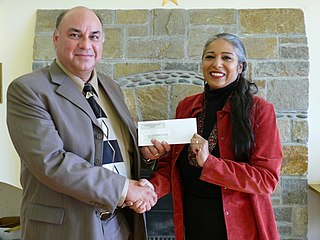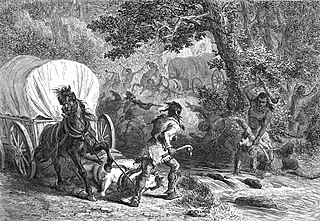
The Mohicans are an Eastern Algonquian Native American tribe that historically spoke an Algonquian language. As part of the Eastern Algonquian family of tribes, they are related to the neighboring Lenape, whose indigenous territory was to the south as far as the Atlantic coast. The Mohican lived in the upper tidal Hudson River Valley, including the confluence of the Mohawk River and into western New England centered on the upper Housatonic River watershed. After 1680, due to conflicts with the powerful Mohawk to the west during the Beaver Wars, many were driven southeastward across the present-day Massachusetts western border and the Taconic Mountains to Berkshire County around Stockbridge, Massachusetts.

The Lenape, also called the Lenni Lenape and Delaware people, are an Indigenous people of the Northeastern Woodlands, who live in the United States and Canada.

Hempstead is a village located in the Town of Hempstead in Nassau County, on Long Island, in New York, United States. The population was 59,169 at the 2020 census, making it the most populous village in New York.

The Town ofHempstead is the largest of the three towns in Nassau County on Long Island, in New York, United States. The town's combined population was 793,409 at the 2020 census, which is the majority of Nassau County's population and makes it, by far, the largest population of any town in the United States.

King Philip's War was an armed conflict in 1675–1676 between a group of indigenous peoples of the Northeastern Woodlands and the English New England Colonies and their indigenous allies. The war is named for Metacomet, the Pokanoket chief and sachem of the Wampanoag who adopted the English name Philip because of the friendly relations between his father Massasoit and the Plymouth Colony. The war continued in the most northern reaches of New England until the signing of the Treaty of Casco Bay on April 12, 1678.

The Wampanoag, also rendered Wôpanâak, are a Native American people of the Northeastern Woodlands currently based in southeastern Massachusetts and formerly parts of eastern Rhode Island. Their historical territory includes the islands of Martha's Vineyard and Nantucket.

The Pequot War was an armed conflict that took place in 1636 and ended in 1638 in New England, between the Pequot tribe and an alliance of the colonists from the Massachusetts Bay, Plymouth, and Saybrook colonies and their allies from the Narragansett and Mohegan tribes. The war concluded with the decisive defeat of the Pequot. At the end, about 700 Pequots had been killed or taken into captivity. Hundreds of prisoners were sold into slavery to colonists in Bermuda or the West Indies; other survivors were dispersed as captives to the victorious tribes.

The Massachusett were a Native American tribe from the region in and around present-day Greater Boston in the Commonwealth of Massachusetts. The name comes from the Massachusett language term for "At the Great Hill," referring to the Blue Hills overlooking Boston Harbor from the south.
Awashonks was a saunkskwa, a female sachem (chief) of the Sakonnet tribe in Rhode Island. She lived near the southern edge of the Plymouth Colony on Patuxet homelands, not far from Narragansett Bay, near what is currently known by settlers as Little Compton, Rhode Island. In the mid-seventeenth century, English settlers of Plymouth Colony invaded her lands. While she had allied herself to the English to increase her power, English colonization eroded her standing among both the English and the Sakonnet. Awashonks is known for her special talent for negotiation and diplomacy, which helped include the Sakonnets among Native communities who received amnesty from colonists.
The Siwanoy were an Indigenous American band of Munsee-speaking people, who lived in Long Island Sound along the coasts of what are now The Bronx, Westchester County, New York, and Fairfield County, Connecticut. They were one of the western bands of the Wappinger Confederacy. By 1640, their territory (Wykagyl) extended from Hell Gate to Norwalk, Connecticut, and as far inland as White Plains; it became hotly contested between Dutch and English colonial interests.

The Montaukett ("Metoac"), more commonly known as Montauk are an Algonquian-speaking Native American people from the eastern and central sections of Long Island, New York.
Wyandanch (c. 1571 – 1659 was a sachem of the Montaukett Indians in the mid-17th century on eastern Long Island. Initially he was a minor chief among the Montaukett, but due to his skillful manipulation of various alliances and his accommodating stance towards the European colonists who gave him substantial military and economic support, he eventually became an influential "alliance chief" (a sachem who was responsible for maintaining friendly relations between his tribe and the settlers).

The Wappinger were an Eastern Algonquian Munsee-speaking Native American people from what is now southern New York and western Connecticut.

Pavonia was the first European settlement on the west bank of the North River that was part of the seventeenth-century province of New Netherland in what would become the present Hudson County, New Jersey.
Oratam was sagamore, or sachem, of the Hackensack Indians living in northeastern New Jersey during the period of early European colonization in the 17th century. Documentation shows that he lived an unusually long life and was quite influential among indigenous and immigrant populations.
Hackensack was the exonym given by the Dutch colonists to a band of the Lenape, or Lenni-Lenape, a Native American tribe. The name is a Dutch derivation of the Lenape word for what is now the region of northeastern New Jersey along the Hudson and Hackensack rivers. While the Lenape people occupied much of the mid-Atlantic area, Europeans referred to small groups of native people by the names associated with the places where they lived.

The Battle of Bloody Brook was fought on September 28, 1675 between an indigenous war party primarily composed of Pocumtuc warriors and other local indigenous people from the central Connecticut River valley, and the English colonial militia of the New England Confederation and their Mohegan allies during King Philip's War.
The Pound Ridge massacre was a battle of Kieft's War that took place in March 1644 between the forces of New Netherland and members of the Wappinger Confederacy at a village of its members in the present-day town of Pound Ridge, New York. A mixed force of 130 New Netherland soldiers led by Captain John Underhill launched a night attack on the village and destroyed it with fire. 500 to 700 members of the Wappinger Confederacy were killed while the New Netherland force lost one man killed and fifteen wounded. More casualties were suffered in this attack than in any other single incident in the war. Shortly after the battle several local Wappinger Confederacy sachems sued for peace.
The Wangunk or Wongunk were an Indigenous people from central Connecticut. They had three major settlements in the areas of the present-day towns of Portland, Middletown, and Wethersfield. They also used lands in other parts of what were later organized by English settlers as Middlesex and Hartford counties. Some sources call the Wangunk the Mattabessett, or Mattabesch, but Wangunk is the name used by scholars and by contemporary Wangunk descendants.

The New York Dutch, also known simply as Dutchmen, were a cultural group native to New York and New Jersey found along the old borders of New Netherland; these American Hollanders were known collectively as the Holland Dutch. The ancestors of the New York and Jersey Dutch were the New Netherlanders, the settlers of New Netherland.













